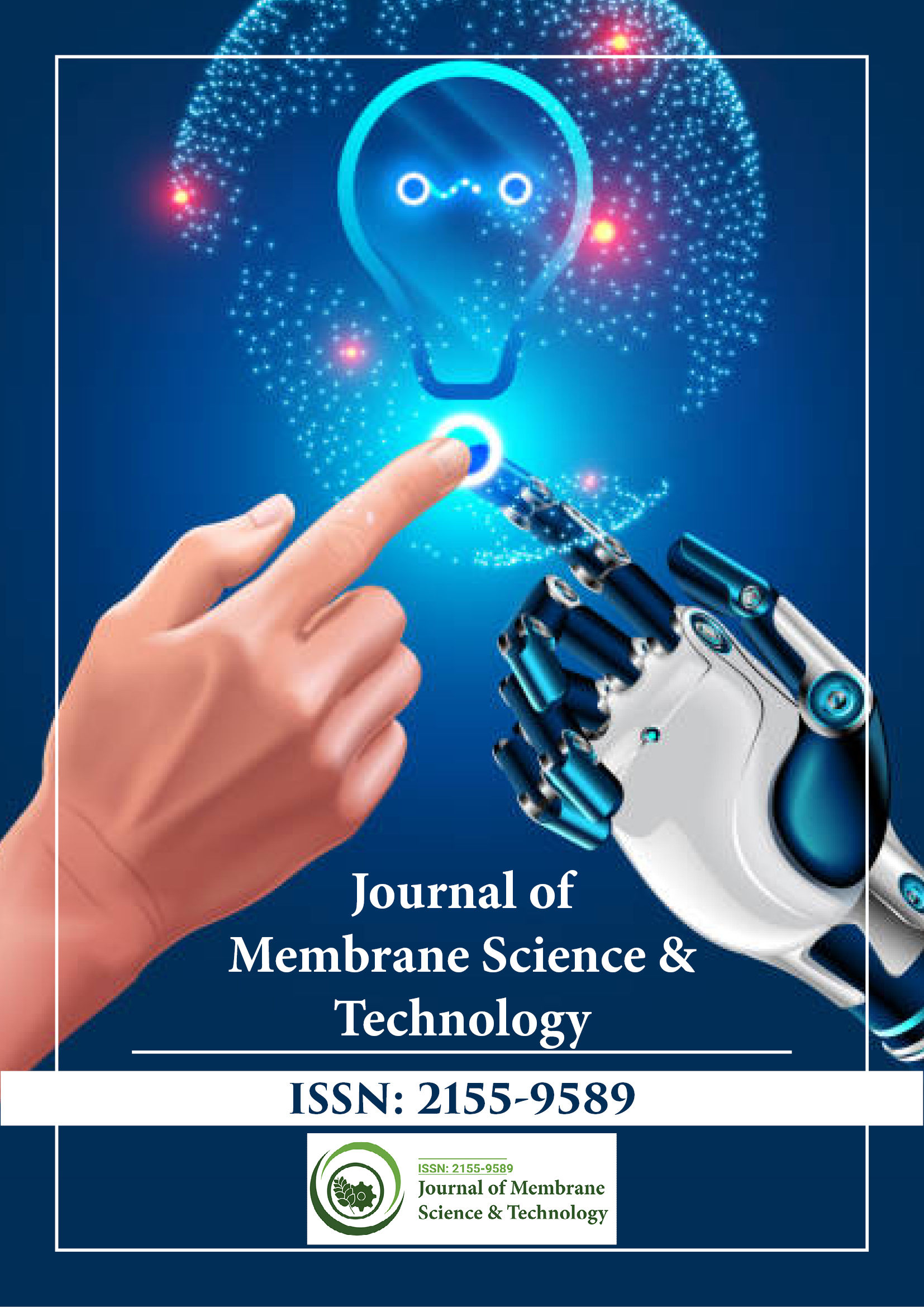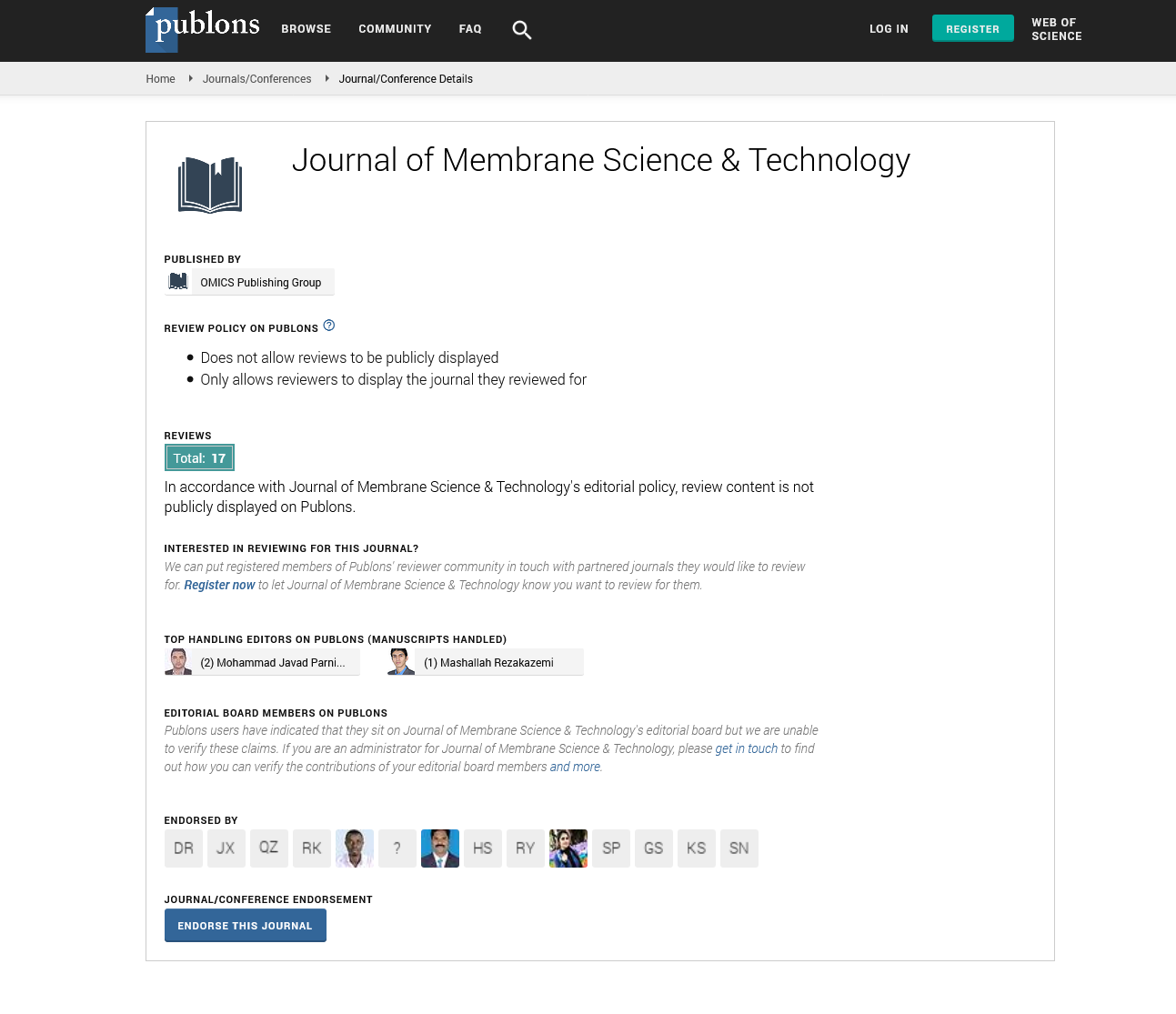Indexed In
- Open J Gate
- Genamics JournalSeek
- Ulrich's Periodicals Directory
- RefSeek
- Directory of Research Journal Indexing (DRJI)
- Hamdard University
- EBSCO A-Z
- OCLC- WorldCat
- Proquest Summons
- Scholarsteer
- Publons
- Geneva Foundation for Medical Education and Research
- Euro Pub
- Google Scholar
Useful Links
Share This Page
Journal Flyer

Open Access Journals
- Agri and Aquaculture
- Biochemistry
- Bioinformatics & Systems Biology
- Business & Management
- Chemistry
- Clinical Sciences
- Engineering
- Food & Nutrition
- General Science
- Genetics & Molecular Biology
- Immunology & Microbiology
- Medical Sciences
- Neuroscience & Psychology
- Nursing & Health Care
- Pharmaceutical Sciences
Perspective - (2024) Volume 14, Issue 4
Applications and Benefits of Electrospun Nanofiber Membranes in Water Treatment
Sofia Yun*Received: 29-Nov-2024, Manuscript No. JMST-24-27299; Editor assigned: 02-Dec-2024, Pre QC No. JMST-24-27299 (PQ); Reviewed: 16-Dec-2024, QC No. JMST-24-27299; Revised: 23-Dec-2024, Manuscript No. JMST-24-27299 (R); Published: 30-Dec-2024, DOI: 10.35248/2155-9589.24.14.404
Description
Electrospun nanofiber membranes have emerged as an innovative solution in water treatment, known for their high surface area, porous structure and tunable properties. These membranes, fabricated using the electrospinning technique, allow for efficient filtration and contaminant removal, providing alternatives to traditional filtration methods. This article describes the structural, synthetic techniques and performance analysis of electrospun nanofiber membranes for water treatment, discussing their benefits, applications and challenges.
Electrospinning in nanofiber membrane fabrication
Electrospinning is a versatile and scalable process that uses an electric field to draw a polymer solution into fine fibers. These fibers are deposited onto a collector, forming a non-woven, nanofibrous membrane. Electrospun fibers can range in diameter from a few nanometers to several micrometers, enabling high filtration efficiency due to their large surface-to- volume ratio and customizable pore structure.
The process allows control over membrane characteristics by adjusting parameters such as polymer concentration, voltage and collector distance. This customization is significant in structuring membranes for specific water treatment applications, as it enables the selection of fiber morphology, hydrophobicity and mechanical properties to enhance filtration performance.
Advantages of electrospun nanofiber membranes in water treatment
Electrospun nanofiber membranes offer several advantages that make them ideal for water treatment applications:
High surface area and porosity: The nanofiber structure provides a high surface area, which increases the number of active sites available for contaminant capture. This structure also contributes to the membrane’s porosity, enabling high permeate flux and reducing the likelihood of clogging.
Tunable pore size and morphology: Electrospinning allows precise control over fiber diameter and pore size. By adjusting these parameters, researchers can structural membranes with specific filtration properties, enabling the selective removal of contaminants based on size, charge, or hydrophobicity.
Considerations in electrospun nanofiber membranes
Structuring the electrospun nanofiber membranes for water treatment involves several lead considerations to optimize filtration performance:
Polymer selection: The choice of polymer influences the membrane's mechanical strength, chemical resistance and hydrophobicity. Common polymers include polyvinylidene Fluoride (PVDF), Peroxyacetyl Nitrate (PAN) and Polyethersulfone (PES), each offering unique benefits. For example, PVDF provides high chemical resistance, while PAN offers excellent mechanical strength, making it suitable for high- pressure applications.
Fiber diameter and morphology: Adjusting electrospinning parameters, such as voltage and solution concentration, controls fiber diameter and morphology. Smaller fiber diameters increase surface area and enhance filtration performance but may reduce membrane permeability. Finding the right balance between fiber size and permeability is essential for achieving efficient filtration.
Applications of electrospun nanofiber membranes in water treatment
Electrospun nanofiber membranes have shown in a range of water treatment applications:
Microfiltration and ultrafiltration: The tunable pore size of electrospun nanofiber membranes makes them suitable for microfiltration and ultrafiltration processes, effectively removing suspended particles, bacteria and larger organic molecules from water.
Heavy metal removal: Functionalized electrospun membranes with metal-binding agents or adsorbents can capture heavy metals such as lead, cadmium and mercury. This capability is critical for treating industrial wastewater and protecting ecosystems from heavy metal contamination.
Pathogen removal: Electrospun membranes can be functionalized with antimicrobial agents, such as silver nanoparticles, to prevent bacterial growth and biofouling. This application is valuable in drinking water treatment, where pathogen removal is essential for public health.
Conclusion
Electrospun nanofiber membranes offer a versatile and efficient solution for water treatment, with applications ranging from microfiltration to heavy metal removal. Their high surface area, tunable properties and functionalization significant to make them ideal for removing contaminants and improving water quality. While challenges such as fouling, durability and scalability remain, advancements in materials, green fabrication techniques and hybrid structures are only for electrospun membranes to become a valuable tool in sustainable water treatment. Continued research and innovation are essential to realize the full significance in an electrospun nanofiber membranes in addressing global water challenges.
Citation: Yun S (2024). Applications and Benefits of Electrospun Nanofiber Membranes in Water Treatment. J Membr Sci Technol. 14:404.
Copyright: © 2024 Yun S. This is an open-access article distributed under the terms of the Creative Commons Attribution License, which permits unrestricted use, distribution, and reproduction in any medium, provided the original author and source are credited.

